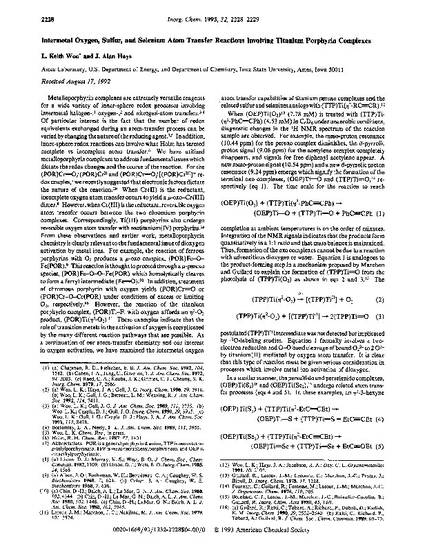
Article
Intermetal Oxygen, Sulfur, and Selenium Atom Transfer Reactions Involving Titanium Porphyrin Complexes
Inorganic Chemistry
Document Type
Article
Disciplines
Publication Version
Published Version
Publication Date
5-1-1993
DOI
10.1021/ic00063a002
Abstract
Metalloporphyrin complexes are extremely versatile reagents for a wide variety of inner-sphere redox processes involving intermetal halogen-, 1 oxygen-,2 and nitrogen-atom transfers.3.4 Of particular interest is the fact that the number of redox equivalents exchanged during an atom-transfer process can be varied by changing the nature of the reducing agent. 3·5 In addition, inner-sphere redox reactions can involve what Holm has termed complete vs incomplete atom transfer.6 We have utilized metalloporphyrin complexes to address fundamental issues which dictate the redox changes and the course of the reaction. For the (POR)Cr=O I (POR)Cr11 and (POR)Cr=O I [ (POR)Criii] + redox couples, 7 we recently suggested that electronic factors dictate the nature of the reaction. 2b When Cr(II} is the reductant, incomplete oxygen atom transfer occurs to yield a ll-oxo-Cr(III) dimer. s However, when Cr(III) is the reductant, reversible oxygen atom transfer occurs between the two chromium porphyrin complexes. Correspondingly, Ti(III) porphyrins also undergo reversible oxygen atom transfer with oxotitanium(IV) porphyrins. 2a From these observations and earlier work, metalloporphyrin chemistry is clearly relevant to the fundamental issue of dioxygen activation by metal ions. For example, the reaction of ferrous porphyrins with 0 2 produces a ll-oxo complex, (POR)Fe-0-Fe( POR). 9 This reaction is thought to proceed through a ll-peroxo species, (POR)Fe-0--0--Fe(POR) which homolytically cleaves to form a ferry! intermediate (Fe=0). 10 In addition, treatment of chromous porphyrin with oxygen yields (POR)Cr=O or (POR)Cr-0--Cr(POR) under conditions of excess or limiting 0 2, respectively. 8b However, the reaction of the titanium porphyrin complex, (POR)Ti-F, with oxygen affords an 712-0 2 product, (POR)Ti(772-02}. 11 These examples indicate that the role of transition metals in the activation of oxygen is complicated by the many different reaction pathways that are possible. As a continuation of our atom-transfer chemistry and our interest in oxygen activation, we have examined the intermetal oxygen atom transfer capabilities of titanium peroxo complexes and the related sulfur and selenium analogs with (TTP)Ti(7J2·RO=CR).I2
Copyright Owner
American Chemical Society
Copyright Date
1993
Language
en
File Format
application/pdf
Citation Information
L. Keith Woo and J. Alan Hays. "Intermetal Oxygen, Sulfur, and Selenium Atom Transfer Reactions Involving Titanium Porphyrin Complexes" Inorganic Chemistry Vol. 32 Iss. 11 (1993) p. 2228 - 2229 Available at: http://works.bepress.com/l-woo/23/

Reprinted (adapted) with permission from Inorganic Chemistry 32 (1993): 2228, doi:10.1021/ic00063a002. Copyright 1993 American Chemical Society.